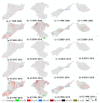Carbon Storage Change Analysis and Emission Reduction Suggestions under Land Use Transition: A Case Study of Henan Province, China
- PMID: 33672829
- PMCID: PMC7918624
- DOI: 10.3390/ijerph18041844
Carbon Storage Change Analysis and Emission Reduction Suggestions under Land Use Transition: A Case Study of Henan Province, China
Abstract
The significant spatial heterogeneity among river basin ecosystems makes it difficult for local governments to carry out comprehensive governance for different river basins in a special administrative region spanning multi-river basins. However, there are few studies on the construction of a comprehensive governance mechanism for multi-river basins at the provincial level. To fill this gap, this paper took Henan Province of China, which straddles four river basins, as the study region. The chord diagram, overlay analysis, and carbon emission models were applied to the remote sensing data of land use to analyze the temporal and spatial patterns of carbon storage caused by land-use changes in Henan Province from 1990 to 2018 to reflect the heterogeneity of the contribution of the four basins to human activities and economic development. The results revealed that food security land in the four basins decreased, while production and living land increased. Ecological conservation land was increased over time in the Yangtze River Basin. In addition, the conversion from food security land to production and living land was the common characteristic for the four basins. Carbon emission in Henan increased from 134.46 million tons in 1990 to 553.58 million tons in 2018, while its carbon absorption was relatively stable (1.67-1.69 million tons between 1990 and 2018). The carbon emitted in the Huai River Basin was the main contributor to Henan Province's total carbon emission. The carbon absorption in Yellow River Basin and Yangtze River Basin had an obvious spatial agglomeration effect. Finally, considering the current need of land spatial planning in China and the goal of carbon neutrality by 2060 set by the Chinese government, we suggested that carbon sequestration capacity should be further strengthened in Yellow River Basin and Yangtze River Basin based on their respective ecological resource advantages. For future development in Hai River Basin and Huai River Basin, coordinating the spatial allocation of urban scale and urban green space to build an ecological city is a key direction to embark upon.
Keywords: Henan province; LUCC; carbon emissions; ecological compensation; multi-river basins.
Conflict of interest statement
The authors declare no conflict of interest.
Figures







References
-
- Hu M., Li Z., Wang Y., Jiao M., Li M., Xia B. Spatio-temporal chan ges in ecosystem service value in response to land-use/cover changes in the Pearl River Delta. Resour. Conserv. Recycl. 2019;149:106–114. doi: 10.1016/j.resconrec.2019.05.032. - DOI
-
- Marina M.S., Cabral-Pinto M.I., Orquídia N., Almeida A.A., Pinto E., Oliveiros B., Ferreira da Silva E.A. Human health risk assessment due to agricultural activities and crop consumption in the surroundings of an industrial area. Expo. Health. 2020;12:629–640.
-
- Alkimim A., Clarke K.C. Land use change and the carbon debt for sugarcane ethanol production in Brazil. Land Use Policy. 2018;72:65–73. doi: 10.1016/j.landusepol.2017.12.039. - DOI
-
- Cao W., Yuan X. Region-county characteristic of spatial-temporal evolution and influencing factor on land use-related CO2 emissions in Chongqing of China, 1997–2015. J. Clean. Prod. 2019;231:619–632. doi: 10.1016/j.jclepro.2019.05.248. - DOI
Publication types
MeSH terms
Substances
LinkOut - more resources
Full Text Sources
Other Literature Sources
Miscellaneous

